Best food in Lisbon from Portugal’s ex-colonies

Portugal’s maritime explorations were launched mostly back in the 15th century. Not only did they chart parts of the globe, which obviously already existed, but that were until then mostly unknown for Europeans, they also laid the groundwork for a complex network of colonies across Asia, Africa, and South America. This period of exploration and colonization, driven by the pursuit of new trade routes and the desire for economic expansion, significantly impacted the cultures and peoples of these regions. While it’s crucial to acknowledge the darker aspects of this era, including exploitation and cultural imposition, we can’t deny that these explorations gave rise to a rich culinary exchange that has deeply influenced Lisbon’s dining scene until today.

Photo by Quadell on Wikipedia
The decolonization of the 20th century brought a significant influx of immigrants from Portugal’s former colonies to our country. These communities sought to recreate the flavors of their homelands, initially for their own diaspora, leading to the establishment of authentic eateries scattered across Lisbon. These restaurants served as the first bridges between the Portuguese and the cuisines of the former colonies, introducing lisboetas to a world of flavors previously unknown.
Over time, the integration of these immigrant communities into Portuguese society led to a fascinating culinary fusion, blending traditional Portuguese ingredients and dishes with the exotic flavors and techniques from the colonies. This fusion is not merely a blending of ingredients but a reflection of Portugal’s multicultural identity, shaped by centuries of global trade, migration, and cultural exchange. For instance, the use of spices such as cinnamon, cloves, and turmeric in Portuguese cuisine can be traced back to the spice trade with India, while the popularity of dishes like peri-peri chicken reveal African influences.
As we explore Lisbon’s dining scene, it’s essential to recognize the mutual influence between Portuguese cuisine and the culinary traditions of its former colonies. The global trade routes not only introduced new flavors to Europe but also brought European culinary techniques and world ingredients to the rest of the world, giving birth to foods whose origin you may not know was actually Portuguese, and shaping global cuisines in a way that continues to evolve.

Photo by Craig G. on Yelp
Today, Lisbon offers the unique opportunity to explore the diverse flavors brought to its shores from around the world. And so we’d love to recommend to you not only the greatest restaurants in Lisbon but also the best foods you can try from Portugal’s ex-colonies, some of which may not be that easy to come by in other parts of the world, unless you go to their country of origin.
Goan cuisine in Lisbon
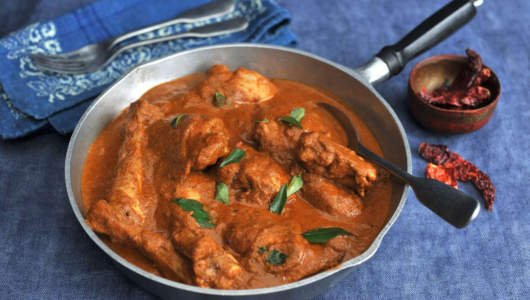
Photo via CookAway
The integration of Goa, Daman and Diu into the Portuguese Empire back in the 16th century marked the beginning of a culinary exchange that would blend the rich spices of India with Portuguese cooking traditions. This fusion gave rise to distinctive dishes, particularly in the region of Goa, that mix the heat of Indian spices with the subtlety of Portuguese flavors, creating a unique cuisine that celebrates the best of both worlds.
Back in the 16th century, Goa saw the introduction of Portuguese ingredients such as vinegar, pork, and potatoes (now so integral to the Indian diet). Combined with Goa’s rich array of spices like tamarind, cardamom, and black pepper, these ingredients were at the base of the development of a distinct culinary tradition celebrated for its depth of flavor and complexity.
In Lisbon, Goan cuisine is a tasty materialization of the cultural exchanges between Portugal and its former colony. Most Goan restaurants in Lisbon came up once the Portuguese Empire in India was dismantled, post 1961.
Now-a-days, we can taste iconic dishes like vindaloo, a fiery pork dish with a tangy vinegar base, which was an adaptation of Portuguese vinha d’alhos, that is, meat marinated with wine and garlic, which in Goa started being cooked with palm vinegar as wine was not an available product. Xacuti or chacuti (pictured above) is another good example of the depth and richness of Goan flavors, as it consists of a complex curry made with roasted spices and coconut. Seafood also plays a significant role in Goan cuisine, with dishes like fish curry and prawn balchão showcasing the coastal region’s bounty, not only enhanced by the subtle influence of Portuguese cooking methods and ingredients but in the case of balchão, also including cooking techniques that, already back in those days, the Portuguese would have already brought over from Macau. The layered dessert bebinca, even though Goan, clearly has Portuguese influences, as can be observed by the copious amounts of egg yolks used in the recipe, something that not only is uncommon when talking about other Indian desserts, but that is one of the distinctive characteristics of Portuguese conventual sweets.
In parallel to what could be considered straightforward Goan food, the culinary connection between Goa and Mozambique, facilitated by Portuguese colonialism, led to the creation of Indo-Mozambican cuisine. This cuisine featured a unique blend of Goan spices, Portuguese cooking methods, and Mozambican ingredients. This fusion cuisine, exemplified by dishes such as chamuças (samosas), peri-peri chicken (also known as piri-piri chicken), and flavorful seafood curries, embodies the rich mix of flavors from these diverse cultures. In Lisbon, we’re also thankful for the presence of restaurants which display examples of Indo-Mozambican cuisine, some of which we explore below, in the section dedicated to the cuisines of former Portuguese colonies in Africa.
If you’re looking to sample the historical ties that bind Portugal and Goa in a delicious way, we recommend the following Goan restaurants in Lisbon:
Jesus é Goês
 🍴By far, one of the most celebrated Goan restaurants in Lisbon. It was founded by the late Jesuslee, a Goan native who moved to Lisbon at the young age of 14 y.o., and who became an iconic figure of Lisbon’s dining scene, and who unfortunately passed away in 2023 in his mid 40s. His legacy is alive and well at Jesus é Goês, where you can taste incredible dishes such as crab and prawn samosas, crispy soft shell crab, prawn masala, sarapatel (a dish of Portuguese origin now-a-days much more prevalent in Goa than in Portugal, made with pork, offal and a variety of spices), and even sweet samosas stuffed with dates for dessert.
🍴By far, one of the most celebrated Goan restaurants in Lisbon. It was founded by the late Jesuslee, a Goan native who moved to Lisbon at the young age of 14 y.o., and who became an iconic figure of Lisbon’s dining scene, and who unfortunately passed away in 2023 in his mid 40s. His legacy is alive and well at Jesus é Goês, where you can taste incredible dishes such as crab and prawn samosas, crispy soft shell crab, prawn masala, sarapatel (a dish of Portuguese origin now-a-days much more prevalent in Goa than in Portugal, made with pork, offal and a variety of spices), and even sweet samosas stuffed with dates for dessert.
📍Rua São José 23, 1150-352 Lisbon
www.instagram.com/jesusegoesoficial
Photo by Jesus é Goês
Tentações de Goa
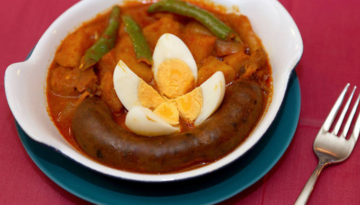 🍴This Goan restaurant run by chef Maria dos Anjos is a great spot to try Goan samosas, quite different than the standard idea of samosa many travelers used to northern Indian restaurants may be used to. Because of Portuguese Christian influence, contrary to other parts of India where Hinduism was and is the main religion, Goan samosas are usually non-vegetarian, most commonly stuffed with ground meat or seafood.
🍴This Goan restaurant run by chef Maria dos Anjos is a great spot to try Goan samosas, quite different than the standard idea of samosa many travelers used to northern Indian restaurants may be used to. Because of Portuguese Christian influence, contrary to other parts of India where Hinduism was and is the main religion, Goan samosas are usually non-vegetarian, most commonly stuffed with ground meat or seafood.
📍Rua de São Pedro Mártir 23, 1100-555 Lisbon
www.facebook.com/TentacoesDeGoa
Photo by Time Out Lisboa
Sabores de Goa
 🍴Opened back in 2000, this is a fairly recent addition to Lisbon’s Goan restaurant scene. Sabores de Goa’s specialties include spicy Goan chorizo (with clear Portuguese influences) and crab xec xec, a beloved Goan coconut based curry.
🍴Opened back in 2000, this is a fairly recent addition to Lisbon’s Goan restaurant scene. Sabores de Goa’s specialties include spicy Goan chorizo (with clear Portuguese influences) and crab xec xec, a beloved Goan coconut based curry.
📍Rua do Zaire nº17 B, 1170-397 Lisbon
Photo by Premshree Pillai on Flickr
Segredos de Goa
 🍴In the heart of Campo de Ourique, one of our favorite neighborhoods of Lisbon, Segredos de Goa isn’t a well kept secret no more, as locals into spicy flavors come here often to indulge in beautiful dishes such as stuffed fish, sarapatel, pork vindaloo, bebinca, and more!
🍴In the heart of Campo de Ourique, one of our favorite neighborhoods of Lisbon, Segredos de Goa isn’t a well kept secret no more, as locals into spicy flavors come here often to indulge in beautiful dishes such as stuffed fish, sarapatel, pork vindaloo, bebinca, and more!
📍Rua Ten. Ferreira Durão 62 C, 1350-226 Lisbon
www.facebook.com/segredosdegoa
Photo by Segredos de Goa on TripAdvisor
The best of Brazilian food in Lisbon
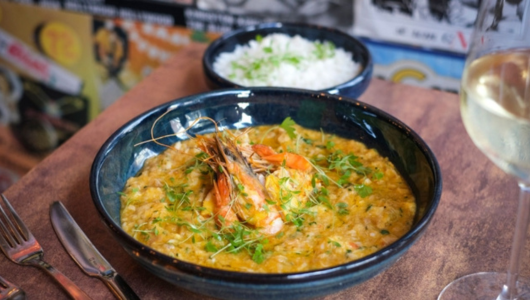
Photo by NIT
When Portugal colonized Brazil in the 16th century, it started the chapter of a complex narrative of exploration, cultural exchange, and the darker history of slavery. This history has deeply influenced Brazilian cuisine, which generally reflects the confluence of Indigenous, African, and Portuguese culinary traditions. The transatlantic slave trade brought millions of Africans to Brazil, whose profound influence on Brazilian culture and cuisine cannot be overstated. African culinary traditions, interwoven with Indigenous and Portuguese practices, have given Brazilian food its distinctive flavors and techniques, seen in dishes like the iconic feijoada, a rich stew of beans, vegetables and various cuts of meats, which is often considered Brazil’s national dish, even though it originated in Portugal.
The historical context of slavery and its impact on Brazilian cuisine is reflected in the ingredients and cooking methods that have become staples of the cuisine. For example, the use of tropical ingredients like cassava, introduced by the Indigenous peoples, and the culinary creativity of African slaves who had to make do with the leftovers from their masters’ tables, contributed to the development of dishes that are celebrated today both in Brazil and Lisbon. The culinary practices brought by enslaved Africans, including the use of coconut milk, palm oil, and okra, enriched Brazilian cuisine, added layers of flavor and complexity.
In Lisbon, the presence of Brazilian cuisine serves as a living testament to this shared history, enriched by the really large Brazilian community that calls the city home today. This community has been instrumental in introducing and popularizing Brazilian foods in Portugal. Not only can we count many Brazilian restaurants in Lisbon and many other parts of Portugal today, at least here in the city there are venues which focus on particular regional cuisines of Brazil, from the seafood-centric dishes of the coastal areas to the hearty, meat-based cuisine of the interior. Furthermore, you could go to any bar in Lisbon and order a capirinha, a typical Brazilian drink based on cachaça (a distilled spirit from fermented sugarcane juice) and lime; or ask for a coxinha (a deep-fried chicken pastry) along with other typical Portuguese savory snacks, on any given local pastelaria.
Apart from Portuguese food, Brazilian cuisine is one of the best culinary experiences you can have in our capital city. These are some of our favorite Brazilian restaurants in Lisbon:
Comida de Santo
 🍴Open for more than 40 years in the Portuguese capital, Comida de Santo serves regional Brazilian food. Stand out dishes include vatapá (shredded fish and dried shrimp cooked in coconut milk), chicken xim xim (shredded coconut and dried fish cooked in palm oil), and an irresistible dessert which they call “O Melhor Quindim da Europa”, being that quindim is a super sweet dessert made with coconut, sugar, and lots of egg yolks (nodding to the Portuguese influences in Brazilian sweet making).
🍴Open for more than 40 years in the Portuguese capital, Comida de Santo serves regional Brazilian food. Stand out dishes include vatapá (shredded fish and dried shrimp cooked in coconut milk), chicken xim xim (shredded coconut and dried fish cooked in palm oil), and an irresistible dessert which they call “O Melhor Quindim da Europa”, being that quindim is a super sweet dessert made with coconut, sugar, and lots of egg yolks (nodding to the Portuguese influences in Brazilian sweet making).
📍Calçada Eng. Miguel Pais 39, 1200-215 Lisbon
Photo by Dicas de Lisboa
Dona Beija
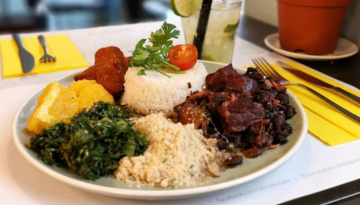 🍴This is the perfect spot to try typical Brazilian petiscos, such as fried chicken coxinhas, and chips made from tapioca or cassava. Celebrated Brazilian dishes include bobó de camarão (a curry-like dish of shrimp and manioc in coconut milk) and tacacá (an INdigenous dish from the Amazon region, prepared with regional vegetables and dried shrimp). To try Brazilian food with a Portuguese twist, order linguiça Portuguesa na cachaça, a Portuguese chorizo grilled over the Brazilian spirit in flames.
🍴This is the perfect spot to try typical Brazilian petiscos, such as fried chicken coxinhas, and chips made from tapioca or cassava. Celebrated Brazilian dishes include bobó de camarão (a curry-like dish of shrimp and manioc in coconut milk) and tacacá (an INdigenous dish from the Amazon region, prepared with regional vegetables and dried shrimp). To try Brazilian food with a Portuguese twist, order linguiça Portuguesa na cachaça, a Portuguese chorizo grilled over the Brazilian spirit in flames.
📍Av. Duque de Loulé 22b, 1050-085 Lisbon
Photo by Lifecooler
Boteco Dona Luzia
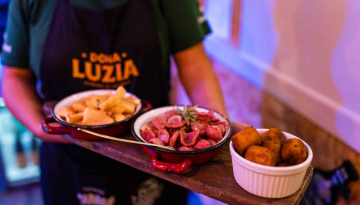 🍴A boteco is for brazilians what a tasca is for us Portuguese. At this unpretentious establishment in Saldanha, amongst many other dishes, you can taste luso-brazilian dishes, feijoada à brasileira (unlike the Portuguese feijoada, Brazilian bean stew is served with farofa, which is flavored toasted cassava meal), BBQed meats (Brazilians love churrasco!), as well as coconut based cocada for dessert.
🍴A boteco is for brazilians what a tasca is for us Portuguese. At this unpretentious establishment in Saldanha, amongst many other dishes, you can taste luso-brazilian dishes, feijoada à brasileira (unlike the Portuguese feijoada, Brazilian bean stew is served with farofa, which is flavored toasted cassava meal), BBQed meats (Brazilians love churrasco!), as well as coconut based cocada for dessert.
📍Avenida 5 de Outubro 36 – D, 1050-053 Lisbon
Photo by Lisboa Secreta
African cuisines from Portugal’s former colonies

Photo by Visão
The relationship between Portugal and its former African colonies (Angola, Mozambique, Cape Verde, Guinea-Bissau, and São Tomé and Príncipe) presents a complex history that has kept evolving over the centuries, and which naturally reflects when it comes to food too.
The connection between Portugal and Africa initiated in the 15th century, when Portugal started focusing on its maritime explorations and colonial ambitions, which helped shape the cuisines of some of these African nations, as well as Portugal. Across these former colonies, the Portuguese influence is evident in the use of spices and fiery chili peppers which were brought over from Central America, and ingredients like cassava and maize (particularly in the shape of funge, a smooth, polenta-like side made from cassava or corn flour), as well as some tropical fruits and vegetables which have been integrated into the local cuisines but originated in the Americas and which were introduced thanks to transatlantic trade. The Portuguese tradition of seafood and fish dishes, such as the iconic bacalhau, also found a new expression in parts of Africa, adapted to local tastes and prepared with other available ingredients.
Angola’s cuisine reflects its rich natural resources, with dishes that heavily feature fish, pork, and spices. Muamba de galinha, a spicy chicken stew made with palm oil and okra, exemplifies the fusion of Portuguese cooking techniques with African ingredients. As explored above, Mozambique’s culinary palette was influenced by its coastline and the Portuguese seafood tradition, but also by boulder flavors of the Indian Ocean’s spice route.
When it comes to Cape Verdean cuisine, we can observe a blend of African, Portuguese, and Brazilian influences, notable in the use of corn, beans, and seafood. Cachupa, a hearty stew of hominy, beans, and meat or fish, symbolizes this cultural melange. Guinea-Bissau features a cuisine that relies on fish, rice, and tropical fruits, mirroring the country’s coastal and agricultural landscape, yet with some palpable Portuguese influence which can be seen in the preparation of stews and the use of some spices. Last but not least, São Tomé and Príncipe’s culinary scene is also marked by the extensive use of seafood, namely salted and dry fish, a culinary tradition which was developed in Portugal as far back as the days of the Roman Empire, more than 2000 years ago.
In Lisbon we have both pan-African and country-specific restaurants offering a taste of this heritage. Pan-African eateries in Lisbon provide a broad sampling of the culinary diversity of Portugal’s former colonies in Africa, while other establishments focus on delivering the distinct flavors of each individual country. Furthermore, don’t be surprised if you come across African dishes in some more traditional Portuguese restaurants, as iconic recipes such as cachupa or muamba (also known as moamba or muambe) are so well liked, that locals crave them often independently of the venue they decide to visit.
If you are interested in sampling the diverse cuisines of Portugal’s former colonies in Africa, we recommend visiting these restaurants.
The best Mozambican restaurants in Lisbon:
Cantinho do Aziz
 🍴This is one of our favorite Mozambican restaurants in Lisbon and it’s a prime example of not only authentic Mozambican food but also Indo-Mozambican cuisine. If you’d like some guidance to explore Cantinho do Aziz’s menu, while listening to stories about the connection between India, Mozambique and Portugal live, join our Lisbon Roots and Cultural Walk.
🍴This is one of our favorite Mozambican restaurants in Lisbon and it’s a prime example of not only authentic Mozambican food but also Indo-Mozambican cuisine. If you’d like some guidance to explore Cantinho do Aziz’s menu, while listening to stories about the connection between India, Mozambique and Portugal live, join our Lisbon Roots and Cultural Walk.
📍Rua de São Lourenço 5, 1100-530 Lisbon
Photo by Travel Noire
Chiveve
 🍴If you’re generally into peri-peri chicken, when you come to Chiveve we recommend trying the frango à Zambeziana, a creamy version of grilled chicken. The matapa, featuring crab and mashed cassava leaves, cooked along with coconut milk and peanuts, is also outstanding and promises to take you on a trip to Africa with your tastebuds!
🍴If you’re generally into peri-peri chicken, when you come to Chiveve we recommend trying the frango à Zambeziana, a creamy version of grilled chicken. The matapa, featuring crab and mashed cassava leaves, cooked along with coconut milk and peanuts, is also outstanding and promises to take you on a trip to Africa with your tastebuds!
📍Rua Andrade Corvo 5D, 1050-007 Lisbon
www.instagram.com/chiveverestaurante
Photo by Chiveve
Roda Viva
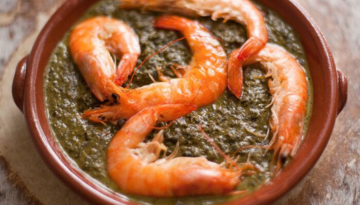 🍴Roda Viva specializes in the food from Southern Mozambique. Amongst others, this translates into dishes such as crab and chicken curry, matapa (see above), and mokofo, which is a typical Mozambican dish with cabbage, coconut milk and peanuts.
🍴Roda Viva specializes in the food from Southern Mozambique. Amongst others, this translates into dishes such as crab and chicken curry, matapa (see above), and mokofo, which is a typical Mozambican dish with cabbage, coconut milk and peanuts.
📍Beco do Mexias 11 R/c, 1100-349 Lisbon
www.facebook.com/RodaVivaAlfama
Photo by Roda Viva
Best Cape Verdean food in Lisbon:
Associação Caboverdeana
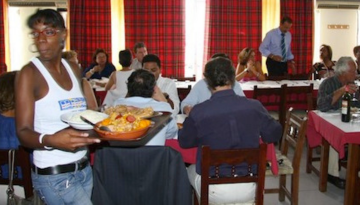 🍴Ask a Cape Verdean descent person in Lisbon what is their preferred place to go for authentic food from Cape Verde and, after their Mom’s place, they’ll probably mention Associação Caboverdeana (formerly known as Casa de Cabo Verde). The menu changes every day so there’s always a good excuse to come back, but iconic dishes such as cachupa are fixed and always a great option.
🍴Ask a Cape Verdean descent person in Lisbon what is their preferred place to go for authentic food from Cape Verde and, after their Mom’s place, they’ll probably mention Associação Caboverdeana (formerly known as Casa de Cabo Verde). The menu changes every day so there’s always a good excuse to come back, but iconic dishes such as cachupa are fixed and always a great option.
📍Rua Duque de Palmela 2 8° andar, 1250-098 Lisbon
Photo by Lifecooler
Tambarina
🍴Tambarina serves traditional Cape Verdean food with live music to make the atmosphere even more authentic. They prepare several versions of cachupa, either with meat or fish, as well as muamba or other typical African dishes such as cassava with beef.
📍Rua do Poço dos Negros 94, 1200-109 Lisbon
www.instagram.com/tambarinarestaurante
Photo by On The Grid
Djairsound
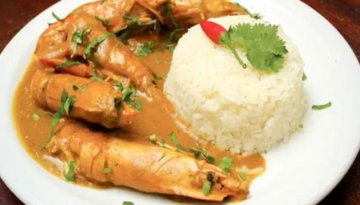 🍴Djairsound, as the name clearly implies, is also into live music. This is a very vibrant venue (restaurant+bar) where you can come enjoy a typical meal from Cape Verde and dance the night away with locals and Lisbon residents of Cape Verdean descent. The festive atmosphere is complemented with typical foods such as bacalhau moqueca, cachupa, moamba, and different types of meat and fish grills, with sides like funge, manioc, beans in palm oil, cassava meal, fried plantains, and more.
🍴Djairsound, as the name clearly implies, is also into live music. This is a very vibrant venue (restaurant+bar) where you can come enjoy a typical meal from Cape Verde and dance the night away with locals and Lisbon residents of Cape Verdean descent. The festive atmosphere is complemented with typical foods such as bacalhau moqueca, cachupa, moamba, and different types of meat and fish grills, with sides like funge, manioc, beans in palm oil, cassava meal, fried plantains, and more.
📍Rua das Janelas Verdes 22, 1200-869 Lisbon
Photo by The Fork
Where to sample Angolan food in Lisbon:
Casa de Angola
 🍴More than a mere restaurant, Casa de Angola is a cultural and gastronomic venue. The building, which is also used for artist residencies, houses the restaurant which is very popular thanks to its excellent value for money lunch special. Whether it’s for lunch or dinner, we recommend trying the chicken moamba with funge, as well as the mufete, a typical dish from Luanda, Angola’s capital city, which consists of grilled fish served with beans cooked in palm oil, cassava, plantains, a vinegary sauce and chili peppers.
🍴More than a mere restaurant, Casa de Angola is a cultural and gastronomic venue. The building, which is also used for artist residencies, houses the restaurant which is very popular thanks to its excellent value for money lunch special. Whether it’s for lunch or dinner, we recommend trying the chicken moamba with funge, as well as the mufete, a typical dish from Luanda, Angola’s capital city, which consists of grilled fish served with beans cooked in palm oil, cassava, plantains, a vinegary sauce and chili peppers.
📍Travessa da Fábrica das Sedas 7, 1250-096 Lisbon
www.facebook.com/casadeangola.net
Photo by Casa de Angola on Facebook
Other good African restaurants in Lisbon, focusing on the cuisines from Portuguese speaking countries, include:
Casa Mocambo
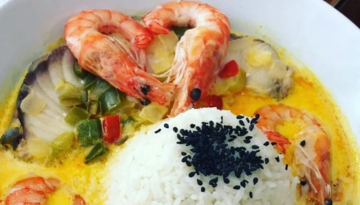 🍴This Afro-Lisbon fusion restaurant also serves as art gallery and venue for events. Their menu features cachupa, moqueca, moamba, Brazilian feijoada, Goan curries, and more. An overall outstanding place to come to taste food from Portugal’s former colonies, not only in the African world but also in Asia and South America!
🍴This Afro-Lisbon fusion restaurant also serves as art gallery and venue for events. Their menu features cachupa, moqueca, moamba, Brazilian feijoada, Goan curries, and more. An overall outstanding place to come to taste food from Portugal’s former colonies, not only in the African world but also in Asia and South America!
📍Rua do Vale de Santo António 122A, 1170-378 Lisbon
Photo by Casa Mocambo on Facebook
Criolense Kitchen Club
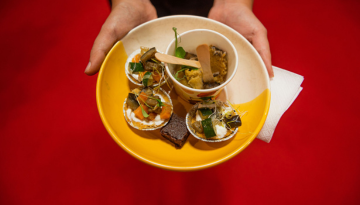 🍴A self-described restaurant of “contemporary black food”, Criolense Kitchen Club is an experimental place for food and stories that are begging to be shared with the wider world. Here, Afro-Brazilian food is used as a tool to bring people together and to promote cultural openness and understanding.
🍴A self-described restaurant of “contemporary black food”, Criolense Kitchen Club is an experimental place for food and stories that are begging to be shared with the wider world. Here, Afro-Brazilian food is used as a tool to bring people together and to promote cultural openness and understanding.
📍Rua Damasceno Monteiro 12, 1170-112 Lisbon
www.instagram.com/criolensekitchenclub
Photo by doclisboa on Facebook
Mambo
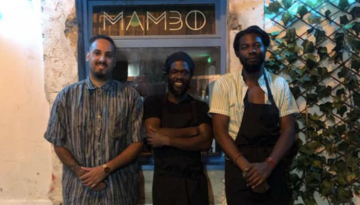 🍴This restaurant was started by trio Duda, from Angola, Gil, with Angolan and Cape-Verdean descent, and Mamadou, from Senegal. Together, they’ve developed a food menu that pays homage to their ancestry and where the vegan cachupa seems to have become one of their best-sellers.
🍴This restaurant was started by trio Duda, from Angola, Gil, with Angolan and Cape-Verdean descent, and Mamadou, from Senegal. Together, they’ve developed a food menu that pays homage to their ancestry and where the vegan cachupa seems to have become one of their best-sellers.
📍Rua da Silva n8, 1200-447 Lisbon
Photo by Travel Noire
Macanese food with Portuguese influences
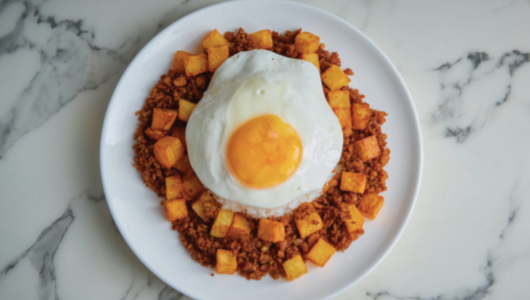
Photo by The Macao News
Macau’s status as a Portuguese territory from the mid-16th century until its handover to China in 1999 created a unique cultural and culinary fusion that is vividly reflected in Macanese cuisine, a testament to the blending of Chinese and Portuguese culinary traditions, ingredients, and techniques.
This cultural exchange married the flavors of Portuguese cuisine with Chinese cooking. A prime example of this fusion is the Macanese version of the pastel de nata, or egg tart, which has become a symbol of Macau’s culinary heritage. Originating from the Portuguese conventual confectionery, the pastel de nata was adapted in Macau to suit local tastes, eventually becoming a popular snack across Asia, often served as dim sum. This adaptation showcases how, in certain examples, Portuguese culinary staples were not only integrated in Macau but, above all, were reimagined within the local culinary context.
The most iconic dishes of Macanese cuisine, such as minchi (pictured above), a comforting minced meat dish seasoned with soy sauce, molasses, and spices, and African chicken, a spicy, coconut-based dish, illustrate the deep culinary connections between Macau and Portugal. The use of spices such as turmeric and cinnamon, alongside ingredients like bacalhau (dried and salted cod) and olive oil, showcases the Portuguese influence (and, on another layer, even of Portuguese other former colonies, which were actual colonies during the days these influences were being applied), while traditional Chinese ingredients and techniques ensure these dishes are firmly rooted in the local culinary scene.
While Macanese restaurants in Lisbon do not abound the same as the examples of other former colonies which we have shared above, there is at least one place where you can taste the food from Macau in our city:
Patuá
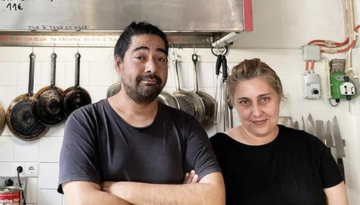 🍴This is the one and only Lisbon restaurant dedicated to Macanese food. Book a table at Patuá and taste minchi in its traditional form, or in its vegan version, with soy marinated to taste as meaty as possible.
🍴This is the one and only Lisbon restaurant dedicated to Macanese food. Book a table at Patuá and taste minchi in its traditional form, or in its vegan version, with soy marinated to taste as meaty as possible.
📍Rua da Ilha de São Tomé 10A B, 1170-185 Lisbon
www.instagram.com/patua.lisboa
Photo by Hoje Macau
Food from East-Timor in Lisbon
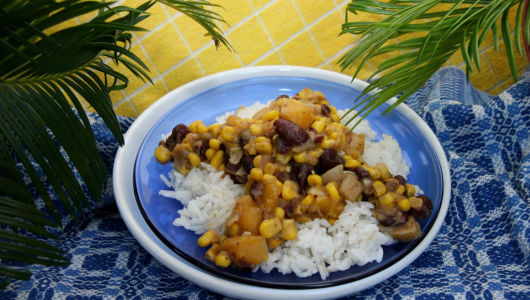
Photo by CSR Rice Bowl
The relationship between Timor-Leste (East Timor) and Portugal dates back to the 16th century when Portuguese traders and missionaries first arrived on the island. This marked the beginning
of a period of Portuguese colonization that lasted until 1975, with a brief interruption during World War II. The enduring legacy of Portuguese influence in Timor-Leste is profoundly evident in its culinary traditions, where the fusion of local ingredients and Portuguese culinary practices has given rise to Timorese cuisine as we now know it.
Portugal’s influence on Timorese culture and cuisine is a reflection of centuries of colonial interaction, which brought European, particularly Portuguese, ingredients and cooking techniques to the island. This culinary exchange was further enriched by the addition of flavors and ingredients from other parts of the Portuguese Empire, including Africa and the Indian subcontinent, creating a unique gastronomic blend.
One of the most iconic dishes that symbolize this fusion is batar da’an, a corn and pumpkin dish (pictured above) that reflects the Timorese adaptation of traditional Portuguese ingredients to local tastes. Another notable dish is feijoada Timorense, a version of the Portuguese bean stew that incorporates local ingredients such as tamarind and local beans, showcasing the integration of Portuguese culinary traditions with the island’s indigenous products. Pudim de coco is a dessert that illustrates the sweet side of Portuguese influence, adapted to incorporate the abundant local coconut, creating a distinctly Timorese version of the traditional Portuguese pudding. Similarly, pão de ló de Timor, a sponge cake that has its roots in Portuguese cuisine, is enjoyed in Timor-Leste with a local twist, often incorporating local flavors such as vanilla or coconut.
Even though the Timorese diaspora is quite notable in Portugal, Lisbon doesn’t have exclusively Timorean restaurants as such, and your best bet to try authentic cooking from Timor would be to be invited to someone’s home.
To try food from Timor as well as other countries from the global Portuguese-speaking world, we recommend booking a table at:
Geographia
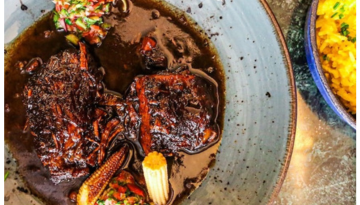 🍴With the slogan “food that speaks Portuguese”, this restaurant has a lovely representation of iconic dishes from countries where Portuguese is the official language, which are the former colonies of Portugal. To represent East-Timor, they serve midar-sin, which is a flavorful dish made with black pork, and saffron infused coconut rice.
🍴With the slogan “food that speaks Portuguese”, this restaurant has a lovely representation of iconic dishes from countries where Portuguese is the official language, which are the former colonies of Portugal. To represent East-Timor, they serve midar-sin, which is a flavorful dish made with black pork, and saffron infused coconut rice.
📍Rua do Conde 1, 1200-608 Lisbon
https://restaurantegeographia.pt/en
Photo by Geographia on Trendy
The culinary landscape of Lisbon is a mosaic of flavors, each telling a story of Portugal’s maritime explorations, colonial past, and the ongoing exchange of cultural and culinary traditions. To keep learning about the foods of Portugal and the broader Lisbon dining scene, sign up for Taste of Lisboa’s newsletter and follow us on Instagram where we post regular updates. #tasteoflisboa
If you’d like history and culture to be added to your Lisbon culinary experience, please feel free to contact us. We’ll be glad to set a customized Lisbon food walk exclusively for you and your party. You may also join one of our daily food & cultural walks.
Explore more about Portuguese Food Culture, while we don’t meet in Lisbon:
Travel around Portugal in 18 foods (without leaving Lisbon)
Foods you didn’t know were Portugueses
10 Portugueses cheeses you must try
Real people, real food. Come with us, where the locals go!
Join us in our natively curated food & cultural experiences.
Follow us for more at Instagram, Twitter and Youtube

